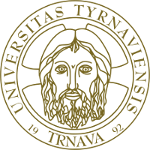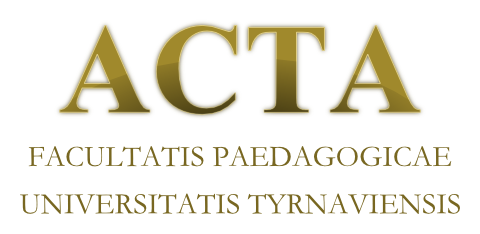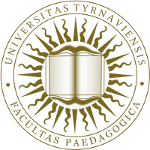 |
 |
 |
Zborník Pedagogickej fakulty Trnavskej univerzity
Séria C – Matematika, Fyzika, Informatika
Ročník 16
Trnava 2012
 |
 |
 |
Zborník Pedagogickej fakulty Trnavskej univerzity
Séria C – Matematika, Fyzika, Informatika
Ročník 16
Trnava 2012
Hlavný redaktor:
doc. RNDr. Pavel Híc, CSc.
Zostavovateľ:
doc. RNDr. Mária Lucká, PhD.
Redakčná rada:
doc. RNDr. Mária Lucká, PhD. (predseda)
prof. RNDr. Ján Čižmár, PhD.
prof. RNDr. Jozef Fulier, CSc.
prof. RNDr. Erika Mechlová, CSc.
doc. RNDr. Peter Čerňanský, CSc.
doc. Ing. Martin Mišút, CSc.
RNDr. Martin Malčík, Ph.D.
Ing. Kateřina Kostolányová, Ph.D.
Recenzenti:
prof. RNDr. Július Krempaský, DrSc.
prof. Ing. František Schauer, DrSc.
doc. RNDr. Peter Čerňanský, CSc.
doc. RNDr. František Lustig, CSc.
doc. RNDr. Miroslava Ožvoldová, CSc.
RNDr. Soňa Halúzková, PhD.
RNDr. Karol Kvetan, CSc.
|
Technický redaktor: |
Ing. Mgr. Roman Horváth |
|
Obálka: |
Ing. Mgr. Roman Horváth |
|
Vydala: |
Trnavská univerzita, Pedagogická fakulta ISBN 978-80-8082-585-0 |
Kontakt na redakciu:
Pedagogická fakulta TU
Priemyselná 4, P.O. Box 9
918 43 Trnava, SR
Telefón:
+421 33 5516 047, kl. 580
+421 917 920 878
|
Fyzika |
|
|
Norbert Beták, Miroslava Ožvoldová: E-HLASOVANIE – komplexná stratégia pre vzdelávanie digitálnej mládeže |
3 |
|
Žaneta Gerhátová: Dať deťom možnosť výberu? |
13 |
|
Žaneta Gerhátová: Fyzika – (ne)obľúbený predmet? |
20 |
|
Michaela Kostelníková, Miroslava Ožvoldová: Aké fyzikálne (ne)vedomosti si odnášajú žiaci zo stredných škôl? |
29 |
|
Július Krempaský, Miroslava Ožvoldová, Peter Čerňanský: Ako ďalej s integrovaným vyučovaním prírodných vied |
39 |
|
Žaneta Gerhátová, Miroslava Ožvoldová: Využitie integrovaného e-learningu vo vyučovaní témy „kmity, vlny, optika“ |
50 |
1Katedra techniky a informačných technológií, Pedagogická fakulta,
Univerzita Konštantína Filozofa, Dražovská 4, 949 74 Nitra & Spojená škola, Komárňanská 28, 940 75 Nové Zámky
e-mail: norbert.betak@gmail.com
2Katedra fyziky, Pedagogická fakulta, Trnavská univerzita
Priemyselná 4, 917 01 Trnava & Fakulta aplikovanej informatiky Univerzity Tomaše Bati v Zlíne,
Nad Stráněmi 4511,760 05 Zlín, CZ
e-mail: mozvoldo@truni.sk, ozvoldova@fai.utb.cz
Abstract: E-voting – a comprehensive strategy for the training of the digital youth. The paper discusses the changes observable in the present young generation growing up in the information society. It stresses the need to respect the educational needs of today’s digital youth. Based on the needs of the Y and Z generations, has been designed and implemented the strategy of interactive teaching in the subject of computer science based on the acquisition of knowledge via inquiry with the support of the voting system. The individual activities of this strategy are presented.
Keywords: e-voiting system, interactive education, information technology
Katedra fyziky, Pedagogická fakulta, Trnavská univerzita
Priemyselná 4, P. O. Box 9, 918 43 Trnava, SR
e-mail: zaneta.gerhatova@truni.sk
Abstract: Give children a possibility of choice? The result and final effectiveness of education is predominantly influenced by the will of a pupil to study and it also depends on his/her interest in a subject. The art of a teacher should be based on his/her ability to raise this interest. One of the possible solutions is to give children a possibility of choice, and to motivate them although they consider the subject boring and uninteresting. The role of the teacher is to lead them to real work even if they tend to comfort and passivity. The paper presents the results of a survey dealing with the physics problems solving designed on the basis of Gardner’s theory of multiple intelligences. The survey was conducted in 2012 in Physics on the sample of 34 Slovak primary school students of 8th grade.
Keywords: selection, intelligence, seven types of intelligence
Katedra fyziky, Pedagogická fakulta, Trnavská univerzita
Priemyselná 4, P. O. Box 9, 918 43 Trnava, SR
e-mail: zaneta.gerhatova@truni.sk
Abstract: Physics – (un)popular subject? Physics – the science about the world around us – represents one of the most beautiful branches of human knowledge. Nevertheless, it is one of the most unpopular subjects among pupils and students. In the paper we present the partial results of a research realized in academic year 2011/2012 on the sample of 131 students of Slovak faculty of education. One of the aims we set was to identify the relation of these students to Physics. We also wanted to find out why only the minimum of the students of the Faculty of Education choose Physics as their approbation subject.
Keywords: Physics, students, popular subject, unpopular subject, questionnaire
1Katedra fyziky, Pedagogická fakulta, Trnavská univerzita
Priemyselná 4, P. O. Box 9, 918 43 Trnava, SR
e-mail: mozvoldo@truni.sk
2Ústav matematiky, Fakulta aplikované informatiky, Univerzita Tomáše Bati ve Zlíně
Nad Stráněmi 4511, 760 05 Zlín, CZ
e-mail: ozvoldova@fai.utb.cz
Abstract: What (dis)information do the students take from secondary schools? In the paper we present the results of the research disseminated among secondary school students, university students and adults. We tested their physics knowledge by means of 40 physical quotes. The average score of a test was a little more than 57 %. There was no significant difference between the results of grammar schools students and vocational schools students. These findings are discussed and appropriate solutions are proposed.
Keywords: physics knowledge, research, test, misconceptions
1Katedra fyziky, Pedagogická fakulta, Trnavská univerzita
Priemyselná 4, P. O. Box 9, 918 43 Trnava, SR
e-mail: mozvoldo@truni.sk
2Ústav matematiky, Fakulta aplikované informatiky, Univerzita Tomáše Bati ve Zlíně
Nad Stráněmi 4511, 760 05 Zlín, CZ
e-mail: ozvoldova@fai.utb.cz
Abstract: How to proceed with integrated learning of science. The article deals with the issues of the integrated teaching of science at all levels of schools. It should be strongly distinguished integrated learning content of natural sciences from the integrated methods of mediation of this content. The subject of this paper focuses mostly on the first area of the problem. In the second part, the text concentrates on concrete proposals in the area of effective teacher training to the more modern way of teaching. The essential feature of this modernization of teaching consists in changing the “horizontal” level distribution of the curriculum to the “vertical” integration, based on the genesis of the individual parts of natural science, as can be seen from “The Science Tree”. An appropriate model of education is proposed.
Keywords: natural science, integrated education, the science tree, teacher training, integrated e-learning
1Trnavská univerzita v Trnave, Pedagogická fakulta, Katedra fyziky
Priemyselná 4, P. O. Box 9, 918 43 Trnava, SR
e-mail: zaneta.gerhatova@truni.sk
2Univerzita Tomaše Bati ve Zlíně, Fakulta aplikované informatiky, Ústav matematiky
Nad Stráněmi 4511, 760 05 Zlín, CZ
e-mail: mozvoldo@truni.sk, ozvoldova@fai.utb.cz
Abstract: The Utilization of Integrated E-learning in the Theme “Oscillations, waves and optics”. The presented studies is aimed at the utilization of Integrated e-Learning (INTe-L) in the theme “Oscillations, Waves and Optics” in primary and secondary school physics education. INTe-L is new strategy of teaching and learning science and technical subjects. It is composed of three components: real or real remote experiments, virtual experiments and study e-materials. The goal of the INTe-L strategy is to improve the quality of science and technical subjects education via observations and active experimentation with the utilization of all forms of experiments and the latest information and communication technologies. The individual INTe-L components were implemented to project assignments in the theme “Oscillations, Waves and Optics” in primary and secondary school physics education.
Keywords: integrated e-learning, optics, oscillations, project, waves